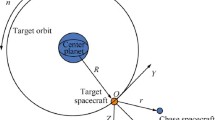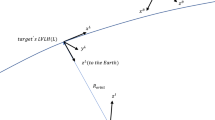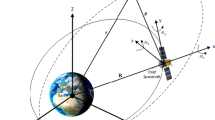Abstract
Periodic gain continuous control strategies are applied to the nonlinear time periodic equations of spacecraft relative motion when the chief orbit is elliptic. Specifically, control strategies based on time-varying linear quadratic regulator (LQR), Lyapunov–Floquet transformation (LFT) with time-invariant LQR, LFT with backstepping, and feedback linearization are implemented and shown to be much more fuel efficient than constant gain feedback control. Both natural and constrained leader-follower two-spacecraft formations are studied. Furthermore, a dead-band control is added for the constrained formation to reduce the amount of the fuel used. The closed-loop response and control effort required are investigated and compared for the same settling time envelopes for all control strategies.

















Similar content being viewed by others
References
Alfriend K, Vadali S, Gurfil P, How J, Breger L (2009) Spacecraft formation flying: dynamics, control, and navigation. Elsevier
Lange B, Smith R (1966) The application of Floquet theory to the computation of small orbital perturbations over long time intervals using the Tschauner–Hempel equations. International Astronautical Federation, pp 61–93
Sherrill R, Sinclair A, Sinha S, Lovell TA (2013) Lyapunov–Floquet transformation of satellite relative motion in elliptic orbits. In: 23rd AAS/AIAA spaceflight mechanics meeting. Kauai, pp 1–19
Sinclair A, Sherrill R, Lovell TA (2013) Calibration of linearized solutions for satellite relative motion. In: 23rd AAS/AIAA spaceflight mechanics meeting. Kauai, pp 1–15
Yamada K, Kimura M, Shima T, Yoshikawa S (2012) New state transition matrix for formation flying in \(J_2\)-perturbed elliptic orbits. J Guid Control Dyn 35(2):536–547
Sengupta P, Sharma R, Vadali S (2006) Periodic relative motion near a Keplerian elliptic orbit with nonlinear differential gravity. J Guid Control Dyn 29(5):1110–1121
Vaddi S, Vadali S, Alfriend K (2003) Formation flying: accommodating nonlinearity and eccentricity perturbations. J Guid Control Dyn 26(2):214–223
Gómez G, Marcote M (2006) High-order analytical solutions of Hill’s equations. Celest Mech Dyn Astron 94:197–211
Sinclair A, Sherrill R, Lovell TA (2012) Review of the solutions to the Tschauner–Hempel euations for satellite relative motion. In: AIAA/AAS astrodynamics specialists conference, Minneapolis, pp 733–746
Massari M, Bernelli-Zazzera F, Canavesi S (2012) Nonlinear control of formation flying with state constraints. J Guid Control Dyn 35(6):1919–1925
Schaub H, Junkins J (2009) Analytical mechanics of space systems. AIAA, Reston
Sinha S, Joseph P (1994) Control of general dynamic systems with periodically varying parameters via Liapunov–Floquet transformation. J Dyn Syst Meas Control 116:650–658
Deshmukh V, Sinha S, Joseph P (2000) Order reduction and control of parametrically excited dynamical systems. J Vib Control 6:1017–1028
Slotine J-JE, Li W (1991) Applied nonlinear control. Prentice Hall, Upper Saddle River
Curtis H (2014) Orbital mechanics for engineering students, Third edn. Elsevier, Waltham
Nazari M, Butcher EA, Bobrenkov OA (2014) Optimal feedback control strategies for periodic delayed systems. Int J Dyn Control 2(1):102–118
Deshmukh V, Sinha S (2004) Control of dynamic systems with time-periodic coefficients via the Lyapunov–Floquet transformation and backstepping technique. J Vib Control 10:1517–1533
Mukherjee R, Chen D (1993) Asymptotic stability theorem for autonomous systems. J Guid Control Dyn 16:961–963
Nazari M, Butcher E, Mesbahi A (2013) On control of spacecraft relative motion in the case of an elliptic Keplerian chief. In: AAS/AIAA astrodynamics specialist conference, Paper AAS 13–798. Hilton Head Island
Acknowledgments
We are grateful for contribution of Dr. Afshin Mesbahi for the derivations of the control gain matrix for the constant gain feedback control [Eq. (43)].
Author information
Authors and Affiliations
Corresponding author
Rights and permissions
About this article
Cite this article
Nazari, M., Butcher, E.A. Fuel efficient periodic gain control strategies for spacecraft relative motion in elliptic chief orbits. Int. J. Dynam. Control 4, 104–122 (2016). https://doi.org/10.1007/s40435-014-0126-1
Received:
Revised:
Accepted:
Published:
Issue Date:
DOI: https://doi.org/10.1007/s40435-014-0126-1




